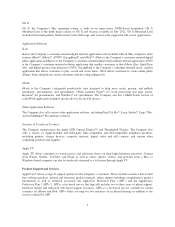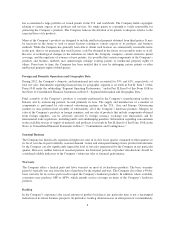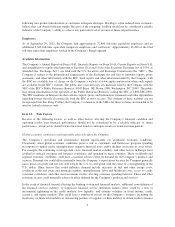Apple 2012 Annual Report Download - page 16
Download and view the complete annual report
Please find page 16 of the 2012 Apple annual report below. You can navigate through the pages in the report by either clicking on the pages listed below, or by using the keyword search tool below to find specific information within the annual report.Company’s more typical retail stores. Due to the high fixed cost structure associated with the Retail segment, a
decline in sales or the closure or poor performance of individual or multiple stores could result in significant
lease termination costs, write-offs of equipment and leasehold improvements, and severance costs.
Many factors unique to retail operations, some of which are beyond the Company’s control, pose risks and
uncertainties. These risks and uncertainties include, but are not limited to, macro-economic factors that could
have an adverse effect on general retail activity, as well as the Company’s inability to manage costs associated
with store construction and operation, failure to manage relationships with its existing retail channel partners,
more challenging environments in managing retail operations outside the U.S., costs associated with
unanticipated fluctuations in the value of retail inventory, and inability to obtain and renew leases in quality retail
locations at a reasonable cost.
Investment in new business strategies and acquisitions could disrupt the Company’s ongoing business and
present risks not originally contemplated.
The Company has invested, and in the future may invest, in new business strategies or acquisitions. Such
endeavors may involve significant risks and uncertainties, including distraction of management from current
operations, greater than expected liabilities and expenses, inadequate return of capital, and unidentified issues not
discovered in the Company’s due diligence. These new ventures are inherently risky and may not be successful.
The Company’s products and services may experience quality problems from time to time that can result in
decreased sales and operating margin.
The Company sells complex hardware and software products and services that can contain design and
manufacturing defects. Sophisticated operating system software and applications, such as those sold by the
Company, often contain “bugs” that can unexpectedly interfere with the software’s intended operation. The
Company’s online services may from time to time experience outages, service slowdowns, or errors. Defects may
also occur in components and products the Company purchases from third parties. There can be no assurance the
Company will be able to detect and fix all defects in the hardware, software and services it sells. Failure to do so
could result in lost revenue, significant warranty and other expenses, and harm to the Company’s reputation.
The Company is subject to laws and regulations worldwide, changes to which could increase the Company’s
costs and individually or in the aggregate adversely affect the Company’s business.
The Company is subject to laws and regulations affecting its domestic and international operations in a number
of areas. These U.S. and foreign laws and regulations affect the Company’s activities including, but not limited
to, areas of labor, advertising, digital content, consumer protection, real estate, billing, e-commerce, promotions,
quality of services, telecommunications, mobile communications and media, television, intellectual property
ownership and infringement, tax, import and export requirements, anti-corruption, foreign exchange controls and
cash repatriation restrictions, data privacy requirements, anti-competition, environmental, health, and safety.
By way of example, laws and regulations related to mobile communications and media devices in the many
jurisdictions in which the Company operates are extensive and subject to change. Such changes could include,
among others, restrictions on the production, manufacture, distribution, and use of the device, locking the device
to a carrier’s network, or mandating the use of the device on more than one carrier’s network. These devices are
also subject to certification and regulation by governmental and standardization bodies, as well as by cellular
network carriers for use on their networks. These certification processes are extensive and time consuming, and
could result in additional testing requirements, product modifications, delays in product shipment dates, or
preclude the Company from selling certain products.
Compliance with these laws, regulations and similar requirements may be onerous and expensive, and they may
be inconsistent from jurisdiction to jurisdiction, further increasing the cost of compliance. This increases the
costs of doing business, and any such costs, which may rise in the future as a result of changes in these laws and
15
























